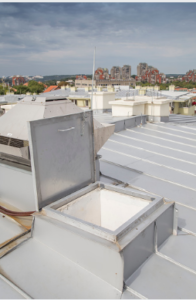Roof access hatches provide convenient access to rooftops of buildings for maintenance work or enjoying rooftop terraces, while providing added security against unauthorised personnel entering to access HVAC equipment or other components on the roof.
 AceAccessHatches roof access hatches provide workers with safety features and weatherproof performance for buildings, making this choice advantageous in several ways. This blog post will highlight some of the main advantages associated with using a roof hatch.
AceAccessHatches roof access hatches provide workers with safety features and weatherproof performance for buildings, making this choice advantageous in several ways. This blog post will highlight some of the main advantages associated with using a roof hatch.
Safety
Roof access hatches provide an easy and safe way to gain entry to rooftops without relying on stairs or ladders, with their secure door that only those authorised can open it. Unfortunately, like all surfaces exposed to weather elements can become damaged; in these instances, it’s vital that physical damages be fixed promptly to continue using it safely.
Safety guidelines require any rooftop opening, including access hatches, to feature guardrails to prevent workers from falling off it. Hatches must also be installed according to slope of roof and provide easy climbing access with low profile for easier climbing on and off roof. A gas-charged opening device should also be added so workers don’t need both hands while trying to open door.
An additional safety feature for hatches should be their ability to resist fire and smoke, helping protect other flammable materials from catching ablaze in case of an incident on the rooftop and burning through ceiling or walls, and providing firefighters access quickly enough to extinguish flames quickly. Some access hatches even come equipped with thermal break features to maintain energy efficiency by keeping heat inside rather than escaping out through rooftop vents.
Ease of Use
Roof accessing workers need access roofs for equipment maintenance and installations. Caged ladders were traditionally used, but these required long vertical climbs with limited space that presented safety risks. AceAccessHatches roof access hatches, on the other hand, install easily over roof openings and secure to the base flange for safe maintenance or installations with easy and safe access.
The top hatches offer uniform lift assistance and an automatic hold-open arm to maintain an open position safely for users, helping prevent the cover from closing accidentally during operation and injuring workers, while simultaneously reducing effort required to operate it while standing on a ladder or stairs with tools in hand. Energy efficiency is also an essential consideration, with most hatches providing insulation in both curb and cover to provide greater thermal performance.
Safety features for buildings may also include exterior and interior padlock hasps to restrict unauthorised access, as well as contact switches for alarm systems. Roof hatches can also come equipped with corrosion-protective coatings depending on their location; galvanised steel products generally make for the least-expensive option while stainless and aluminium hatches require less maintenance while providing greater corrosion resistance.
Energy Efficiency
Roof hatches provide access to roof areas of buildings for routine maintenance, equipment installation and other tasks, such as regular inspection. They may be installed over ladders, traditional service stairs or ship stairs depending on the facility type and size. When choosing the size hatch for an application involving ladders it is critical to specifying an adequate one – otherwise there could be limited headroom and potentially an unsafe situation could ensue.
Thermally broken roof hatch designs minimise heat transfer between rooms in buildings, helping keep interior temperatures warmer during winter and cooler in summer. Many manufacturers also provide options that further increase energy efficiency such as high-performance seals between hatch cover and curb, an insulated frame design, or polyisocyanurate insulation in both parts.
Maintenance
Utilising roof hatches provides an easier means of maintaining the structure of a building and its rooftop installations, as workers can access roofs more readily to perform maintenance or install additional equipment (solar panels, air conditioning units, ventilation systems and lift machine rooms are among many applications that could require accessing them via hatches). Prior to their introduction roofers would use caged ladders which required them to make an arduous climb up onto roofs risking long climbs up and potentially dangerous falls.
To maintain optimal condition for your roof hatch, it’s essential that its hinges and latches are regularly lubricated with oil to reduce friction and wear. Furthermore, cleaning should also take place as required, along with repairs if required. Furthermore, depending on its construction style, the hatch can even be painted to blend in seamlessly.